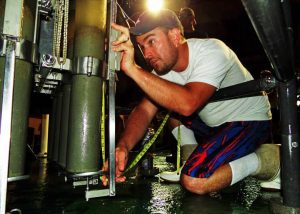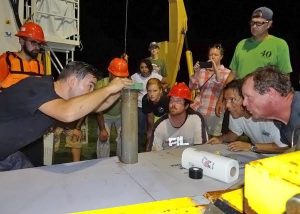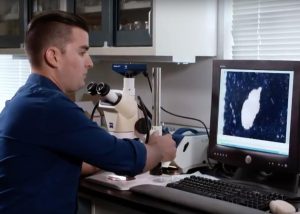Study Documents Initial Impacts and Recovery of Benthic Foraminifera after Deepwater Horizon
– JUNE 8, 2017
Scientists analyzed sediment cores from two sites near the Macondo wellhead to characterize possible spill impacts on benthic foraminifera (single celled organisms with a hard shell). The team found elevated Polycyclic Aromatic Hydrocarbon (PAH) concentrations and a significant decrease in density and species diversity for foraminifera. The first signs of benthic recovery took about 1 – 2 years. The researchers published their findings in Environmental Science and Pollution Research: Characterizing the variability of benthic foraminifera in the northeastern Gulf of Mexico following the Deepwater Horizon event (2010-2012).
Increased flocculent deposition following the oil spill led to elevated PAH levels and altered geochemical conditions in seafloor sediment. Researchers collected sediment cores at 1000-1200 m depth from 2010-2012 at two documented oil plume locations and analyzed benthic foraminiferal fauna, organic chemistry, and metal chemistry. The team used a combined approach of biological measurements (for density and diversity) and environmental chemistry measurements (for hydrocarbon and oxygen concentrations). Results were divided into surface intervals (0 – 10 mm) and down-core intervals (10 – 50 mm).
Down-core samples from both sites resembled those from pre-spill studies. However, the surface interval samples exhibited a 3-fold increase in PAH concentrations and intensified changes in geochemical conditions in late 2010 compared to down-core samples. The surface interval samples representing late-2010 to early-2011 had the greatest difference from the down-core samples, and densities and dominant species of foraminifera resembled those found at natural seep sites.
There was also an absence of certain species that typically dominate natural seep sites, suggesting that they were affected by an oil release rather than a chronic seep. Recovery was gradual from late 2011 and 2012. Samples from one site exhibited protracted density recovery and rapid diversity recovery, while samples from the other site exhibited the opposite, likely the result of opportunistic species that thrive in high-petroleum areas.
Despite differences in foraminiferal community structure, short-term (oil spill) and long-term (natural seeps) hydrocarbon exposure can limit their density and diversity. The timing of the impact and the known effects of petroleum on benthic foraminifera suggest that elevated hydrocarbon concentrations in the upper 10 mm of sediment were the main driver of density and diversity variability. Reduced oxygen concentrations likely acted as a secondary driver of variability.
Study author Patrick Schwing commented on using foraminifera to monitor and mitigate oil’s environmental effects, “Foraminifera are often referred to as the ‘canaries in the coal mine,’ because they are one of the first seafloor communities to respond to changes in their environment. As bioindicators of seafloor health, foraminifera can help us understand benthic habitat suitability for demersal- and benthic-dependent fisheries and provide necessary seafloor recovery time metrics following events such as Deepwater Horizon.”
Data are publicly available through the Gulf of Mexico Research Initiative Information and Data Cooperative (GRIIDC) at doi:10.7266/N79021PB.
Study authors are P.T. Schwing, B.J. O’Malley, I.C. Romero, M. Martinez-Colon, D.W. Hastings, M.A. Glabach, E.M. Hladky, A. Greco, and D.J. Hollander.
************
This research was made possible in part by a grant from the Gulf of Mexico Research Initiative (GoMRI) to the Center for the Integrated Modeling and Analysis of Gulf Ecosystems II (C-IMAGE II), the Deepsea to Coast Connectivity in the Eastern Gulf of Mexico (Deep-C) consortium, and to Eckerd College, Florida International University, Florida State University, the Georgia Institute of Technology, and the University of Florida for their project Assessing the Impact of the Deepwater Horizon Oil Spill on Sediments and Benthic Communities on the West Florida Shelf and Slope.
The Gulf of Mexico Research Initiative (GoMRI) is a 10-year independent research program established to study the effect, and the potential associated impact, of hydrocarbon releases on the environment and public health, as well as to develop improved spill mitigation, oil detection, characterization and remediation technologies. An independent and academic 20-member Research Board makes the funding and research direction decisions to ensure the intellectual quality, effectiveness and academic independence of the GoMRI research. All research data, findings and publications will be made publicly available. The program was established through a $500 million financial commitment from BP. For more information, visit https://gulfresearchinitiative.org/.
© Copyright 2010-2017 Gulf of Mexico Research Initiative (GoMRI) – All Rights Reserved. Redistribution is encouraged with acknowledgement to the Gulf of Mexico Research Initiative (GoMRI). Please credit images and/or videos as done in each article. Questions? Contact web-content editor Nilde “Maggie” Dannreuther, Northern Gulf Institute, Mississippi State University (maggied@ngi.msstate.edu).








